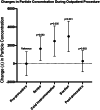Quantification of Aerosol Concentrations During Endonasal Instrumentation in the Clinic Setting
- PMID: 33017067
- PMCID: PMC7675733
- DOI: 10.1002/lary.29122
Quantification of Aerosol Concentrations During Endonasal Instrumentation in the Clinic Setting
Abstract
Objective: Recent anecdotal reports and cadaveric simulations have described aerosol generation during endonasal instrumentation, highlighting a possible risk for transmission of Severe Acute Respiratory Syndrome Coronavirus 2 (SARS-CoV-2) during endoscopic endonasal instrumentation. This study aims to provide a greater understanding of particle generation and exposure risk during endoscopic endonasal instrumentation.
Study design: Prospective quantification of aerosol generation during office-based nasal endoscopy procedures.
Methods: Using an optical particle sizer, airborne particles concentrations 0.3 to 10 microns in diameter, were measured during 30 nasal endoscopies in the clinic setting. Measurements were taken at time points throughout diagnostic and debridement endoscopies and compared to preprocedure and empty room particle concentrations.
Results: No significant change in airborne particle concentrations was measured during diagnostic nasal endoscopies in patients without the need for debridement. However, significant increases in mean particle concentration compared to preprocedure levels were measured during cold instrumentation at 2,462 particles/foot3 (95% CI 837 to 4,088; P = .005) and during suction use at 2,973 particle/foot3 (95% CI 1,419 to 4,529; P = .001). In total, 99.2% of all measured particles were ≤1 μm in diameter.
Conclusion: When measured with an optical particle sizer, diagnostic nasal endoscopy with a rigid endoscope is not associated with increased particle aerosolization in patient for whom sinonasal debridement is not needed. In patients needing sinonasal debridement, endonasal cold and suction instrumentation were associated with increased particle aerosolization, with a trend observed during endoscope use prior to tissue manipulation. Endonasal debridement may potentially pose a higher risk for aerosolization and SARS-CoV-2 transmission. Appropriate personal protective equipment use and patient screening are recommended for all office-based endonasal procedures.
Level of evidence: 3 Laryngoscope, 131:E1415-E1421, 2021.
Keywords: COVID-19; aerosol-generating procedures; droplet quantification; nasal endoscopy; optical particle sizer.
© 2020 American Laryngological, Rhinological and Otological Society Inc, "The Triological Society" and American Laryngological Association (ALA).
Figures



Similar articles
-
Endonasal instrumentation and aerosolization risk in the era of COVID-19: simulation, literature review, and proposed mitigation strategies.Int Forum Allergy Rhinol. 2020 Jul;10(7):798-805. doi: 10.1002/alr.22577. Epub 2020 May 22. Int Forum Allergy Rhinol. 2020. PMID: 32243678
-
Quantification of Aerosol Particle Concentrations During Endoscopic Sinonasal Surgery in the Operating Room.Am J Rhinol Allergy. 2021 Jul;35(4):426-431. doi: 10.1177/1945892420962335. Epub 2020 Oct 4. Am J Rhinol Allergy. 2021. PMID: 33012174 Free PMC article.
-
Airborne Aerosol Generation During Endonasal Procedures in the Era of COVID-19: Risks and Recommendations.Otolaryngol Head Neck Surg. 2020 Sep;163(3):465-470. doi: 10.1177/0194599820931805. Epub 2020 May 26. Otolaryngol Head Neck Surg. 2020. PMID: 32452739 Free PMC article.
-
Diagnostic and therapeutic endonasal rhinologic procedures generating aerosol during COVID-19 pandemic: a systematized review.Braz J Otorhinolaryngol. 2021 Jul-Aug;87(4):469-477. doi: 10.1016/j.bjorl.2020.11.008. Epub 2020 Dec 13. Braz J Otorhinolaryngol. 2021. PMID: 33358322 Free PMC article.
-
Aerosol-generating otolaryngology procedures and the need for enhanced PPE during the COVID-19 pandemic: a literature review.J Otolaryngol Head Neck Surg. 2020 May 11;49(1):29. doi: 10.1186/s40463-020-00424-7. J Otolaryngol Head Neck Surg. 2020. PMID: 32393346 Free PMC article. Review.
Cited by
-
Nasal endoscopy, room filtration, and aerosol concentrations during live outpatient encounters: a prospective, case-control study.Int Forum Allergy Rhinol. 2022 Jan;12(1):71-82. doi: 10.1002/alr.22874. Epub 2021 Aug 6. Int Forum Allergy Rhinol. 2022. PMID: 34355871 Free PMC article.
-
COVID-19 Testing in the Era of Modern Neurosurgery: Mitigating Risk in Our Vulnerable Patient Populations.World Neurosurg. 2021 Aug;152:80-83. doi: 10.1016/j.wneu.2021.06.027. Epub 2021 Jun 13. World Neurosurg. 2021. PMID: 34133996 Free PMC article.
-
Are medical procedures that induce coughing or involve respiratory suctioning associated with increased generation of aerosols and risk of SARS-CoV-2 infection? A rapid systematic review.J Hosp Infect. 2021 Oct;116:37-46. doi: 10.1016/j.jhin.2021.06.011. Epub 2021 Jul 8. J Hosp Infect. 2021. PMID: 34245806 Free PMC article.
-
Quantification and visualization of aerosols in ear, nose, and throat exam and flexible laryngoscopy.Laryngoscope Investig Otolaryngol. 2022 Jun 6;7(4):963-969. doi: 10.1002/lio2.826. eCollection 2022 Aug. Laryngoscope Investig Otolaryngol. 2022. PMID: 36000064 Free PMC article.
-
Control of airborne particles in surgical procedures during the Covid-19 pandemic: scoping review.Rev Esc Enferm USP. 2022 Jul 22;56:e20210579. doi: 10.1590/1980-220X-REEUSP-2021-0579en. eCollection 2022. Rev Esc Enferm USP. 2022. PMID: 35899926 Free PMC article.
References
-
- Nacoti M, Ciocca A, Giupponi A. At the epicenter of the Covid‐19 pandemic and humanitarian crises in Italy: changing perspectives on preparation and mitigation. NEJM Catal. 2020;1. 10.1056/CAT.20.0080. - DOI
-
- Halpern NA, Tan KS, Biostatistician AA. United States Resource Availability for COVID‐19 .
-
- Patel ZM, Fernandez‐Miranda J, Hwang PH, et al. Letter: precautions for endoscopic transnasal skull base surgery during the COVID‐19 pandemic. Available at: https://www.ncbi.nlm.nih.gov/pmc/articles/PMC7184431/. Accessed May 28, 2020. - PMC - PubMed
Publication types
MeSH terms
Substances
Grants and funding
LinkOut - more resources
Full Text Sources
Medical
Research Materials
Miscellaneous

